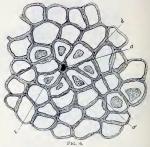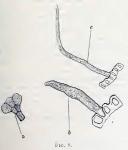Eriodictyon Glutinosum.
Contribution from the Microscopical Laboratory of the Philadelphia College of Pharmacy.
Eriodictyon, or Yerba Santa, as it is more commonly known, is an indigenous shrub, which grows abundantly upon dry hills in the western and southern portions of California. It is a member of the water-leaf family, or natural order Hydrophyllaceae. The genus Eriodictyon to which it belongs, is a very small one, both as to the number of species and the area of distribution. There are only four species known. The generic name Eriodictyon is derived from two Greek words, namely, erion, wool, and diktyon, a net; hence, so called from the finely netted or reticulated veinlets which are conspicuous on a fine woolly ground upon the lower surface. The specific name glutinosum has reference to the viscid character of its upper surface. Eriodictyon glutinosum grows to the height of from three to five feet. The leaves are alternate, and from three to six inches in length. Their general outline is oblong lanceolate, the base tapering into more or less of a petiole. The apex is acute, and the margin is irregularly serrate and beset with rigid teeth. Sometimes the margin is entire. The upper surface is green, smooth and glutinous, which is due to a resinous exudation; the lower surface is whitened between the reticulations by closely matted hairs. The texture is leathery and rigid, the venation pinnate and finely reticulate. The principal veins, which extend from the midrib toward the margin, are mostly alternate from each side of the midrib and near the margin anastomose, forming a rather distinct, wavy, sub-marginal vein. From this, short veins are continued to the margin, terminating at the apex of the rigid teeth. The margin of the dried leaf is slightly revolute, especially near the base.
 Eriodictyon glutinosum was formerly known as Eriodictyon Californicum, and this latter name is still preferred by some botanists. The corolla is tubular funnel-form, half an inch long, thrice the length of the sparsely and slightly hairy calyx.
Eriodictyon glutinosum was formerly known as Eriodictyon Californicum, and this latter name is still preferred by some botanists. The corolla is tubular funnel-form, half an inch long, thrice the length of the sparsely and slightly hairy calyx.
 The plant is popularly known under various synonyms, among which may be mentioned consumptive's weed, mountain balm, saint herb, bear's weed and mountain peach. The leaves were made ofiicial in the U. S. P. of 1890. The fluid extract, which is the only official preparation, is made by percolating the leaves, reduced to a No. 60 powder, with a menstruum consisting of 4 parts of alcohol and 1 part of water. This preparation is given in doses of ½ to 1 fluid drachm (1.8 to 3.7 c.c.). An aromatic syrup and an aromatic elixir, both made from the fluid extract, have been used for some time to disguise the taste of quinine and other bitter substances. The former is known as syrupus corrigens. Yerba Santa is often smoked like tobacco, the smoke being inhaled and giving relief in asthma. The fluid extract is also said to afford relief in the same complaint. The natives of the Pacific Coast have long esteemed it as endowed with rare value in all diseases of the respiratory organs. It has also been used in the form of a tea, and a solid extract has been prepared. One of the most remarkable properties of the drug is its power of completely destroying the bitter taste of quinine, and it is very often prescribed with reference to this property. The leaves have an aromatic odor, and a balsamic and sweetish taste.
The plant is popularly known under various synonyms, among which may be mentioned consumptive's weed, mountain balm, saint herb, bear's weed and mountain peach. The leaves were made ofiicial in the U. S. P. of 1890. The fluid extract, which is the only official preparation, is made by percolating the leaves, reduced to a No. 60 powder, with a menstruum consisting of 4 parts of alcohol and 1 part of water. This preparation is given in doses of ½ to 1 fluid drachm (1.8 to 3.7 c.c.). An aromatic syrup and an aromatic elixir, both made from the fluid extract, have been used for some time to disguise the taste of quinine and other bitter substances. The former is known as syrupus corrigens. Yerba Santa is often smoked like tobacco, the smoke being inhaled and giving relief in asthma. The fluid extract is also said to afford relief in the same complaint. The natives of the Pacific Coast have long esteemed it as endowed with rare value in all diseases of the respiratory organs. It has also been used in the form of a tea, and a solid extract has been prepared. One of the most remarkable properties of the drug is its power of completely destroying the bitter taste of quinine, and it is very often prescribed with reference to this property. The leaves have an aromatic odor, and a balsamic and sweetish taste.
 The medicinal virtues of the drug are supposed to be due to its resinous matters, in which it is exceedingly rich. One investigator separated the following constituents from the drug: Two resins, one soluble in alcohol and one in ether; a bitter principle, soluble in water, and partly so in alcohol; gum; tannin; a fixed and a volatile oil; a peculiar saccharine principle and a crystalline principle, which latter was deposited from a concentrated fluid extract.
The medicinal virtues of the drug are supposed to be due to its resinous matters, in which it is exceedingly rich. One investigator separated the following constituents from the drug: Two resins, one soluble in alcohol and one in ether; a bitter principle, soluble in water, and partly so in alcohol; gum; tannin; a fixed and a volatile oil; a peculiar saccharine principle and a crystalline principle, which latter was deposited from a concentrated fluid extract.
 The object of this thesis, however, is not so much to describe the chemical constituents, physiological action, and preparations of the drug, as to describe the macroscopical and microscopical characters of the leaf, which is the medicinal part of the plant. The structure of the leaf is indicated in the drawings and descriptions which follow:
The object of this thesis, however, is not so much to describe the chemical constituents, physiological action, and preparations of the drug, as to describe the macroscopical and microscopical characters of the leaf, which is the medicinal part of the plant. The structure of the leaf is indicated in the drawings and descriptions which follow:
Drawings.
 The microscopic mounts from which the drawings were made were prepared in the following manner: The sections were made by means of the "Student's Microtome," bleached with Labarraque's solution, washed, stained with iodine green, dehydrated with alcohol and absolute alcohol, then saturated with eosin in oil of cloves and mounted in balsam.
The microscopic mounts from which the drawings were made were prepared in the following manner: The sections were made by means of the "Student's Microtome," bleached with Labarraque's solution, washed, stained with iodine green, dehydrated with alcohol and absolute alcohol, then saturated with eosin in oil of cloves and mounted in balsam.
 The drawings were made by the aid of the camera lucida and the magnification determined by means of the stage micrometer.
The drawings were made by the aid of the camera lucida and the magnification determined by means of the stage micrometer.
In conclusion, I take pleasure in acknowledging the kindness of Messrs. Parke, Davis & Co., of New York, and Prof. E. L. Greene, of the University of California, in providing me with the excellent specimens from which these studies have been made.
The American Journal of Pharmacy, Vol. 67, 1895, was edited by Henry Trimble.


